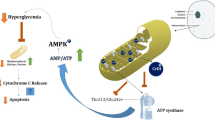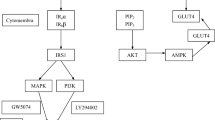Abstract
The aim of this study was to evaluate the impact of three different chromium forms as chromic chloride (CrCl), chromium picolinate (CrPic), and a newly synthesized complex of chromium chelated with small peptides (CrSP) on glucose uptake and metabolism in vitro. In cultured skeletal muscle cells, chromium augmented insulin-stimulated glucose uptake and metabolism as assessed by a reduced glucose concentration of culture medium. At the molecular level, insulin significantly increased the mRNA levels of insulin receptor (IR), glucose transporter 4 (GLUT4), glycogen synthase (GS), and uncoupling protein-3 (UCP3), and these impacts can be enhanced by the addition of chromium, especially in the form of CrSP. Collectively, results of this study demonstrate that chromium improves glucose uptake and metabolism through upregulating the mRNA levels of IR, GLUT4, GS, and UCP3 in skeletal muscle cells, and CrSP has higher efficacy on glucose uptake and metabolism compared to the forms of CrCl and CrPic.


Similar content being viewed by others
References
Vincent JB (2001) The biochemistry of chromium. J Nutr 130:715–718
Stearns DM, Belbruno JJ, Wetterhahn KE (1995) A prediction of chromium(III) accumulation in humans from chromium dietary supplements. FASEB J 9:1650–1657
Speetjens JK, Collins RA, Vincent JB, Woski SA (1999) The nutritional supplement chromium(III) tris(picolinate) cleaves DNA. Chem Res Toxicol 12:483–487
Anderson RA, Bryden NA, Polansky MM, Gautschi K (1996) Dietary chromium effects on tissue chromium concentrations and chromium absorption in rats. J Trace Elem Exp Med 9:11–17
Yang XP, Palanichamy K, Ontko AC, Rao MNA, Fang CX, Ren J, Sreejayan N (2005) A newly synthetic chromium complex—chromium (phenylalanine)3 improves insulin responsiveness and reduces whole body glucose tolerance. FEBS Lett 579:1458–1464
Peng ZL, Qiao W, Zhou AG, Wang ZS, Chen ZH (2008) Absorption of different sources of chromium by broiler chicken. Chin J Anim Nutr 20:128–132
Yoshimoto S, Sakamoto K, Wakabayashi I, Masui H (1992) Effect of chromium administration on glucose tolerance in stroke-prone spontaneously hypertensive rats with streptozotocin induced diabetes. Metabolism 41:636–642
Davis CM, Vincent JB (1997) Chromium oligopeptide activates insulin receptor tyrosine kinase activity. Biochemistry 36:4382–4385
Huppertz C, Fischer BM, Kim YB, Kotani K, Vidal-Puig A, Sliekeri LJ, Sloopi KW, Lowell BB, Kahn BB (2001) Uncoupling protein 3 (UCP3) stimulates glucose uptake in muscle cells through a phosphoinositide 3-kinase-dependent mechanism. J Biol Chem 276:12520–12529
Livak KJ, Schmittgen TD (2001) Analysis of relative gene expression data using real-time quantitative PCR and the 2-ΔΔCT method. Methods 25:402–428
Miranda ER, Dey CS (2004) Effect of chromium and zinc on insulin signaling in skeletal muscle cells. Biol Trace Elem Res 101:19–36
Shinder UA, Sharma G, Xu YJ, Dhalla NS, Goyal RK (2004) Insulin sensitising action of chromium picolinate in various experimental models of diabetes mellitus. J Trace Elem Med Biol 18:23–32
Anderson RA (1998) Chromium, glucose intolerance and diabetes. J Am Coll Nutr 17:548–555
Volek JS, Silvestre RR, Kirwan JP, Sharnan MJ, Judelson DA, Spiering BA, Vingren JL, Maresh CM, Vanheest JL, Kraemer WJ (2006) Effects of chromium supplementation on glycogen synthesis after high-intensity exercise. Med Sci Sports Exerc 38:2102–2109
Baron AD, Brechtel G, Wallace P, Edelman SV (1988) Rates and tissue sites of non-insulin-and insulin-mediated glucose uptake in humans. Am J Physiol 255:E769–E774
DeFronzo RA, Ferrannini E, Sato Y, Felig P, Wahren J (1981) Synergistic interaction between exercise and insulin on peripheral glucose uptake. J Clin Invest 68:1468–1474
Shulman GI, Rothman DL, Jue T, Stein P, DeFronzo RA, Shulman RG (1990) Quantitation of muscle glycogen synthesis in normal subjects and subjects with non-insulin-dependent diabetes by 13C nuclear magnetic resonance spectroscopy. N Engl J Med 322:223–228
Kraegen EW, James DE, Jenkins AB, Chisholm DJ (1985) Dose–response curves for in vivo insulin sensitivity in individual tissues in rats. Am J Physiol 248:E353–E362
Tsao TS, Burcelin R, Katz EB, Huang L, Charron MJ (1996) Enhanced insulin action due to targeted GLUT4 overexpression exclusively in muscle. Diabetes 45:28–36
Tsao TS, Stenbit AE, Li J, Houseknecht KL, Zierath JR, Katz EB, Charron MJ (1997) Muscle-specific transgenic complementation of GLUT4-deficient mice: effects on glucose but not lipid metabolism. J Clin Invest 100:671–677
Hansen PA, Gulve EA, Marshall BA, Gao J, Pessin JE, Holloszy JO, Mueckler M (1995) Skeletal muscle glucose transport and metabolism are enhanced in transgenic mice overexpressing the Glut4 glucose transporter. J Biol Chem 270:1679–1684
Treadway JL, Hargrove DM, Nardone NA, McPherson RK, Russo JF, Milici AJ, Stukenbrok HA, Gibbs EM, Stevenson RW, Pessin JE (1994) Enhanced peripheral glucose utilization in transgenic mice expressing the human GLUT4 gene. J Biol Chem 269:29956–29961
Ren JM, Marshall BA, Mueckler MM, McCaleb M, Amatruda JM, Shulman GI (1995) Overexpression of Glut4 protein in muscle increases basal and insulin-stimulated whole body glucose disposal in conscious mice. J Clin Invest 95:429–432
Deems RO, Evans JL, Deacon RW, Honer CM, Chu DT, Burki K, Fillers WS, Cohen DK, Young DA (1994) Expression of human GLUT4 in mice results in increased insulin action. Diabetologia 37:1097–1104
Leturque A, Loizeau M, Vaulont S, Salminen M, Girard J (1996) Improvement of insulin action in diabetic transgenic mice selectively overexpressing GLUT4 in skeletal muscle. Diabetes 45:23–27
Tsao TS, Stenbit AE, Factor SM, Chen W, Rossetti L, Charron MJ (1999) Prevention of insulin resistance and diabetes in mice heterozygous for GLUT4 ablation by transgenic complementation of GLUT4 in skeletal muscle. Diabetes 48:775–782
Tsao TS, Katz EB, Pommer D, Charron MJ (2000) Amelioration of insulin resistance but not hyperinsulinemia in obese mice overexpressing GLUT4 selectively in skeletal muscle. Metabolism 49:340–346
Pessin JE, Thurmond DC, Elmendorf JS, Coker KJ, Okada S (1999) Molecular basis of insulin-stimulated GLUT4 vesicle trafficking. Location! Location! Location! J Biol Chem 274:2593–2596
Satoh S, Nishimura H, Clark AE, Kozka IJ, Vannucci SJ, Simpson IA, Quon MJ, Cushman SW, Holman GD (1993) Use of bismannose photolabel to elucidate insulin-regulated GLUT4 subcellular trafficking kinetics in rat adipose cells. Evidence that exocytosis is a critical site of hormone action. J Biol Chem 268:17820–17829
Jhun BH, Rampal AL, Liu H, Lachaal M, Jung CY (1992) Effects of insulin on steady state kinetics of GLUT4 subcellular distribution in rat adipocytes. Evidence of constitutive GLUT4 recycling. J Biol Chem 267:17710–17715
Czech MP, Buxton JM (1993) Insulin action on the internalization of the GLUT4 glucose transporter in isolated rat adipocytes. J Biol Chem 268:9187–9190
Bouskila M, Hirshman MF, Jensen J, Goodyear LJ, Sakamoto K (2008) Insulin promotes glycogen synthesis in the absence of GSK3 phosphorylation in skeletal muscle. Am J Physiol Endocrinol Metab 294:E28–E35
Wang ZQ, Zhang XH, Cefalu WT (2000) Chromium picolinate and biotin enhance glycogen synthesis and glycogen synthase gene expression in human skeletal muscle culture. Diabetes Res Clin Pract 50 Supp 1:395
Krook ADJ, O’Rahilly S, Zierath JR, Wallberg-Henriksson H (1998) Uncoupling protein 3 is reduced in skeletal muscle of NIDDM patients. Diabetes 47:1528–1531
Vidal-Puig AJ, Grujic D, Zhang CY, Hagen T, Boss O, Ido Y, Szczepanik A, Wade J, Mootha V, Cortright R, Muoio DM, Lowell BB (2000) Energy metabolism in uncoupling protein 3 gene knockout mice. J Biol Chem 275:16258–16266
Gong DW, Monemdjou S, Gavrilova O, Leon LR, Marcus-Samuels B, Chou CJ, Everett C, Kozak LP, Li C, Deng C, Harper ME, Reitman ML (2000) Lack of obesity and normal response to fasting and thyroid hormone in mice lacking uncoupling protein-3. J Biol Chem 275:16251–16257
Clapham JC, Arch JR, Chapman H, Haynes A, Lister C, Moore GB, Piercy V, Carter SA, Lehner I, Smith SA, Beeley LJ, Godden RJ, Herrity N, Skehel M, Changani KK, Hockings PD, Reid DG, Squires SM, Hatcher J, Trail B, Latcham J, Rastan S, Harper AJ, Cadenas S, Buckingham JA, Brand MD, Abuin A (2000) Mice overexpressing human uncoupling protein-3 in skeletal muscle are hyperphagic and lean. Nature 406:415–418
Li B, Nolte LA, Ju JS, Ho Han D, Coleman T, Holloszy JO, Semenkovich CF (2000) Skeletal muscle respiratory uncoupling prevents diet-induced obesity and insulin resistance in mice. Nat Med 6:1115–1120
Chen NS, Tsai CA, Dyer IA (1973) Effect of chelating agents on chromium absorption in rats. J Nutr 103:1182–1186
Sun Y, Ramirez J, Woski SA, Vincent JB(2000)The binding of trivalent chromium to low-molecular-weight chromium-binding substance (LMWCr) and the transfer of chromium from transferrin and chromium picolinate to LMWCr. JBIC 5:129–136
Acknowledgments
This article was financially supported by the Program for Changjiang Scholars and Innovative Research Team in University, China, IRTO555.
Author information
Authors and Affiliations
Corresponding author
Additional information
All authors listed have contributed to the work and have agreed to submit the manuscript to Biological Trace Element Research. The manuscript is original, has not been published before, and is not under consideration for publication elsewhere.
Rights and permissions
About this article
Cite this article
Qiao, W., Peng, Z., Wang, Z. et al. Chromium Improves Glucose Uptake and Metabolism Through Upregulating the mRNA Levels of IR, GLUT4, GS, and UCP3 in Skeletal Muscle Cells. Biol Trace Elem Res 131, 133–142 (2009). https://doi.org/10.1007/s12011-009-8357-2
Received:
Accepted:
Published:
Issue Date:
DOI: https://doi.org/10.1007/s12011-009-8357-2




